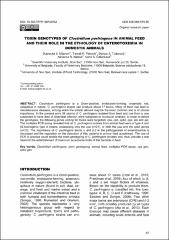Toxin genotypes of Clostridium perfringens in animal feed and their role in the ethiology of enterotoxemia in domestic animals

View/
Date
2018Author
Milanov, Dubravka
Petrović, Tamaš
Todorović, Dalibor
Aleksić, Nevenka
Čabarkapa, Ivana
Metadata
Show full item recordAbstract
Clostridium perfringens is a Gram-positive, endospore-forming, anaerobic rod,
ubiquitous in nature. C. perfringens strains can produce about 17 toxins. Many of them can lead to
miscellaneous diseases, among which the enteric ailment may be the most common and is of utmost
importance. In the present work 34 strains of C. perfringens isolated from feed and one from a cow
suspected to have died of clostridial infection were subjected to molecular analysis. In order to detect
the genotypes, the following genes coding for toxins were targetted: cpa, cpb, cpb2, cpe, etx and iap.
The multiplex PCR assay revealed that all C. perfringens isolates from animal feed were of type A and
2-toxinogenic type A strains, possessing only the cpa (n=21), or both the cpa and the cpb2 genes
(n=13). The importance of C. perfringens toxins and -2 in the pathogenesis of enterotoxemia is
discussed and the regulation on the detection of this bacteria in animal feed questioned. The use of
PCR in practise could enable the toxin-genotyping of C. perfringens isolates and, thus, provide a real
basis for the establishment of maximum acceptable limits of this bacteria in feed.
